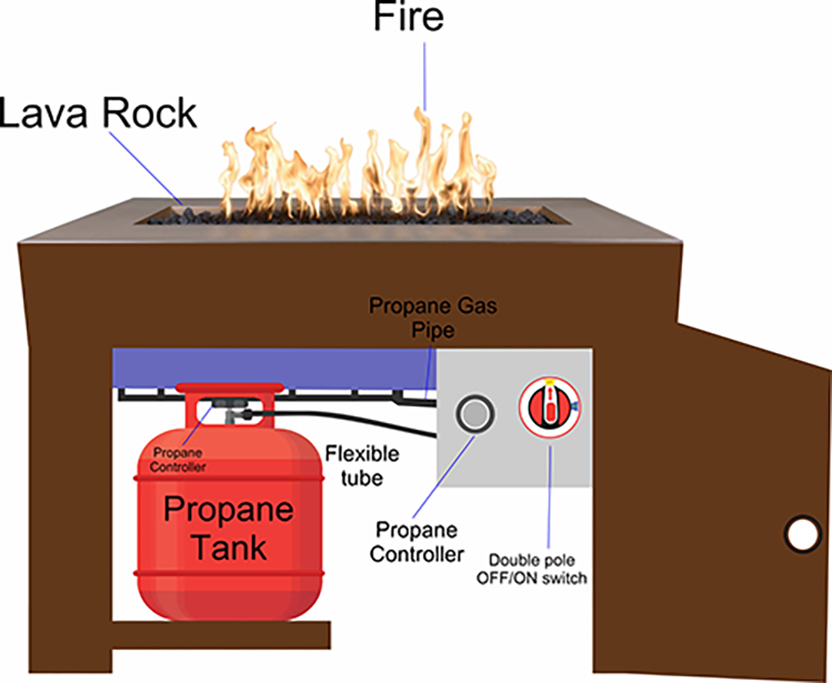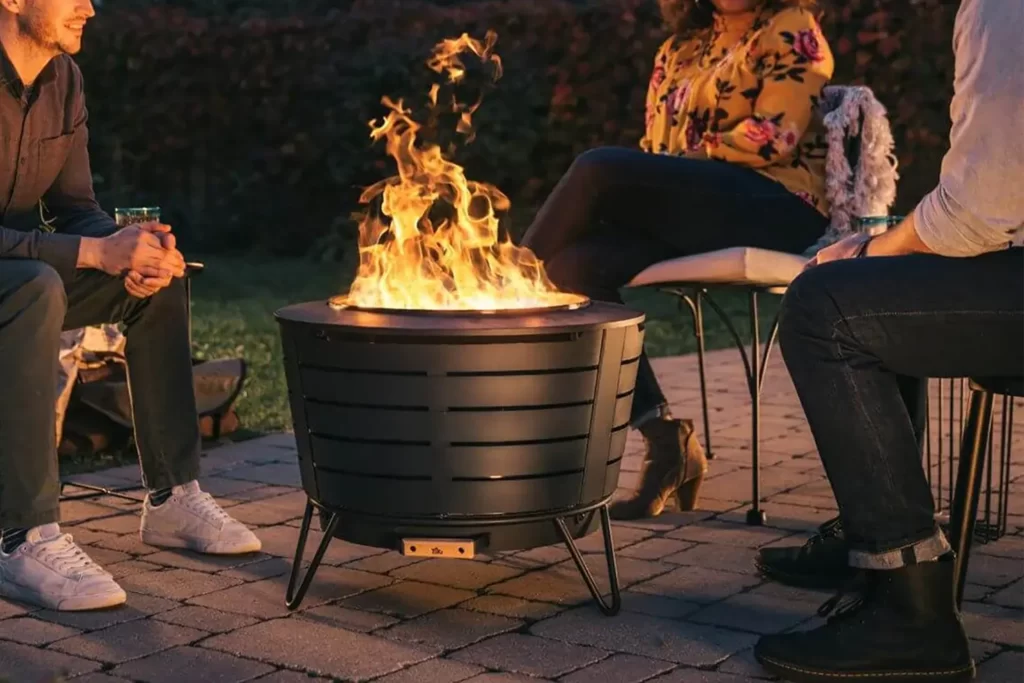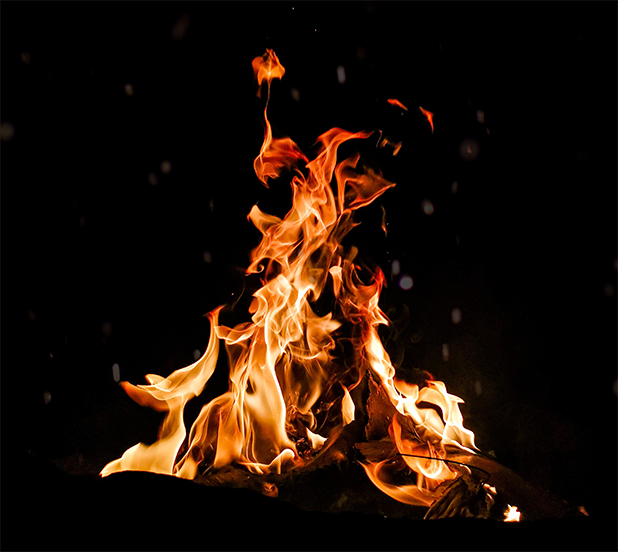Propane fire pits have gained significant popularity as an alternative to traditional wood-burning fire pits. They offer convenience, cleanliness, and versatility, making them an attractive choice for outdoor gatherings. In this article, we will explore the pros and cons of propane fire pits, highlighting their benefits and potential drawbacks.
What is a Propane Firepit
A propane fire pit is a type of outdoor fire feature that uses propane gas as its fuel source. It consists of a burner, a propane tank or connection, and a housing structure that encloses the flames. Propane fire pits are designed to provide a controlled and convenient way to enjoy the warmth and ambiance of a fire in outdoor settings.
Propane fire pits offer several advantages, including easy ignition and control, clean burning with minimal smoke and ash, and portability for use in different outdoor spaces. They are popular for creating a cozy and inviting atmosphere in backyard patios, decks, campsites, or other outdoor gathering areas.
Important Pros of Propane Firepit
| Pros of Propane |
|---|
| 1. Convenience: Propane fire pits are incredibly convenient to use. They can be easily ignited with the flick of a switch or the turn of a knob, providing instant warmth and ambiance. |
| 2. Clean Burning: Propane is a clean-burning fuel, which means it produces fewer emissions compared to other fuel sources like wood. This results in less smoke, soot, and ash, creating a more enjoyable and healthier outdoor experience. |
| 3. Adjustable Flame: Propane fire pits offer adjustable flame settings, allowing you to control the intensity of the fire. Whether you prefer a small, cozy flame or a larger, more dramatic one, you can easily adjust it to suit your preferences. |
| 4. Safety: Propane fire pits are designed with safety in mind. They have built-in safety features such as automatic shut-off valves and flame controls. Additionally, propane is stored in tanks, reducing the risk of accidental fires or sparks from flying embers. |
| 5. Portability: Many propane fire pits are portable, making them versatile for various outdoor settings. Whether you’re camping, hosting a backyard gathering, or simply want to move your fire pit to a different location, propane fire pits are easy to transport. |
| 6. Easy Maintenance: Propane fire pits require minimal maintenance compared to wood-burning fire pits. There’s no need to clean up ashes or deal with the disposal of burnt wood. Simply ensure the propane tank is filled, and you’re ready to enjoy your fire pit. |
| 7. Long Burning Time: Propane tanks have a longer burning time compared to wood, providing hours of warmth and ambiance without the need for frequent refueling. This allows you to enjoy uninterrupted time around the fire pit. |
| 8. Versatility: Propane fire pits come in various styles and designs, allowing you to choose one that complements your outdoor decor. Whether you prefer a traditional or modern look, you can find a propane fire pit to suit your aesthetic preferences. |
| Model | Price Range (USD) |
|---|---|
| Basic Fire Bowl | $100 – $300 |
| Portable Fire Pit | $150 – $400 |
| Tabletop Fire Pit | $50 – $200 |
| Fire Pit Table | $300 – $800 |
| Chiminea | $200 – $600 |
| Fire Pit Kit | $500 – $1,500 |
| Custom-built Fire Pit | Prices vary, depending on design and materials |
| Outdoor Fireplace | $800 – $3,000 |

Benefits of Propane Firepit
| Benefits of Propane Fire Pit |
|---|
| Convenient and Easy to Use: Propane fire pits are simple to operate, as they can be easily ignited and controlled with the turn of a knob or the push of a button. |
| Clean and Smoke-Free: Propane fire pits produce minimal smoke and soot, providing a clean and enjoyable fire experience without the hassle of dealing with wood and ash. |
| Adjustable Flame and Heat: With a propane fire pit, you can easily adjust the flame height and heat output to suit your preferences, creating a comfortable ambiance and warmth. |
| No Need for Firewood: Propane fire pits eliminate the need to gather and store firewood, saving time and effort, and ensuring a consistent fuel source for fires. |
| Portability and Versatility: Propane fire pits are often portable, allowing you to set them up in different locations. They are ideal for camping trips, outdoor events, or backyard gatherings. |
| Quick Ignition and Shutdown: Propane fire pits provide instant ignition and can be easily turned off, allowing for a hassle-free fire experience with no waiting or smoldering embers. |
| Safer Option: Propane fire pits are generally considered safer than traditional wood-burning fire pits since there is no risk of flying sparks, embers, or accidental fires caused by unattended flames. |
| Clean and Low Maintenance: Propane fire pits require minimal maintenance, as there are no ashes or debris to clean up. They also do not leave behind residue on surrounding surfaces. |
| Eco-Friendly: Propane is a clean-burning fuel, and propane fire pits produce fewer emissions compared to wood-burning fire pits, making them a more environmentally friendly choice. |
| Long-lasting Fuel Supply: Propane tanks used for fire pits typically provide a long burn time, allowing for extended use before needing to be refilled or replaced. |
Cons of Propane Firepit
| Cons of Propane |
|---|
| 1. Fuel Cost: Propane fuel can be more expensive compared to other fuel sources, such as wood. The cost of purchasing and refilling propane tanks may be higher in the long run, depending on usage and availability in your area. |
| 2. Dependency on Fuel: Propane fire pits rely on a propane fuel source, which means you need to ensure you have an adequate supply of propane on hand. If you run out of propane while using the fire pit, you’ll need to stop and refill the tank, interrupting your enjoyment. |
| 3. Limited Authenticity: Some people prefer the authenticity and natural ambiance of a wood-burning fire pit. Propane fire pits may not provide the same crackling sound or the distinct aroma associated with burning wood, which can detract from the overall experience for some individuals. |
| 4. Heat Output: While propane fire pits can provide warmth, the heat they generate may be less intense compared to wood-burning fire pits. If you’re looking for a fire pit primarily for heating purposes, you may find that propane fire pits are not as effective at generating high levels of heat. |
| 5. Environmental Impact: Although propane is a cleaner-burning fuel compared to wood, it still releases carbon dioxide when burned. Propane is a fossil fuel, and its production and transportation contribute to carbon emissions and environmental concerns. Choosing sustainable alternatives may be a preference for some individuals. |
| 6. Dependency on Ignition Source: Propane fire pits typically require an external ignition source, such as a match or a lighter, to ignite the flames. This may be considered a minor inconvenience compared to wood-burning fire pits, which can be started with kindling and firewood. |
| 7. Limited Flame Aesthetics: While propane fire pits offer adjustable flame settings, some individuals may find that the flame aesthetics of propane fire pits are not as visually appealing as the dancing flames and natural variations found in wood-burning fire pits. Personal preference plays a significant role here. |
| 8. Risk of Gas Leaks: Although propane fire pits have built-in safety features, there is still a potential risk of gas leaks if the equipment is not properly maintained or if there are faulty components. Regular inspection and maintenance are necessary to minimize this risk. |
Top 10 Propane Firepit
| Propane Fire Pit | Features |
|---|---|
| 1. Outland Living Fire Table | – Propane-powered fire table Durable construction Adjustable flamebr> includes a cover and lava rocks. Easy assembly |
| 2. Heininger Portable Propane Fire Pit | – Portable and lightweight<br>- Smokeless and clean-burning<br>- Quick and easy setup<br>- Comes with a carrying bag<br>- Adjustable flame |
| 3. Bond Manufacturing Stone Look Fire Pit | – Stylish stone look design<br>- Propane-fueled for convenience<br>- Simple ignition and flame control<br>- Includes lava rocks<br>- Weather-resistant |
| 4. Camp Chef Redwood Portable Propane Fire Pit | – Compact and portable<br>- Matchless ignition for easy startup<br>- Adjustable heat control<br>- Comes with a carrying bag<br>- Clean and smokeless burn |
| 5. Blue Rhino Endless Summer Outdoor Fire Pit | – Decorative and durable design<br>- Push-button ignition<br>- Adjustable flame height<br>- Includes lava rocks and protective cover<br>- Easy to set up |
| 6. Real Flame Baltic Square Propane Fire Table | – Modern and sleek square design<br>- Stainless steel burner<br>- Electronic ignition<br>- Adjustable flame<br>- Weather-resistant |
| 7. AZ Patio Heaters Propane Fire Pit | – Powder-coated steel construction<br>- 40,000 BTU heat output<br>- Simple ignition and flame control<br>- Includes lava rocks and cover<br>- Sturdy and durable |
| 8. TACKLIFE Propane Fire Pit Table | – Multi-functional fire pit table<br>- Push-button ignition<br>- Adjustable flame and heat output<br>- Weather-resistant materials<br>- Comes with a cover |
| 9. Bali Outdoors Fire Pit Propane Gas Table | – Elegant design with glass wind guard Easy ignition and flame control Adjustable heat output includes lava rocks. – Weather-resistant |
| 10. Endless Summer Outdoor Propane Gas Fire Pit | hexagonal design with decorative tile mantel Push-button ignition Adjustable flame height includes a protective cover. durable and stylish |
Propane Firepit is an Eco-Friendly
Propane fire pits are an eco-friendly choice for outdoor fires. They produce fewer emissions, such as smoke and soot, resulting in better air quality. Propane has lower carbon emissions compared to burning wood, reducing its environmental impact. Propane fire pits eliminate the need for deforestation and pose a lower risk of wildfires. They also generate minimal ash and residue, reducing waste. While propane is a fossil fuel, using propane fire pits helps minimize the environmental footprint associated with outdoor fires.

Are Propane fire pit Safe?
Propane fire pits are generally safe when used properly and following recommended guidelines. They are designed with built-in safety features, such as automatic shut-off valves and flame controls. Propane fire pits reduce the risk of accidental fires and offer lower fire hazards compared to wood-burning fire pits. However, it is important to ensure proper ventilation, conduct regular maintenance, handle fuel safely, and follow the manufacturer’s guidelines for safe operation. We want to make sure the fire pit has been tested for protection and is “CSA Approved.”
Do Propane Fire Pits Give off Heat
Propane fuels also have energy probable because they provide certain, organized levels of heat. The heat produced by a fire pit flame is easily controlled and made suitable for indoor and outdoor settings.
It gives importance to a heat output to consider. 40,000 Btuh (British Thermal Units Per Hour) is a good average and is the most usual you will see.
- Here is the average burn time for propane tanks on high flame over a 58,000 BTU firepit:
- 10 lbs. – 3.75 hours
- 20 lbs. – 8 hours
- 30 lbs. – 11.5 hours
- 40 lbs. – 15 hours
- 100 lbs. – 37 hours
Which is better Natural Gas or Propane Firepit
| Factors | Natural Gas Fire Pit | Propane Fire Pit |
|---|---|---|
| Fuel Availability | Requires natural gas line connection | Portable with propane tanks |
| Cost | Generally less expensive on a per-unit basis | Propane costs can vary |
| Convenience | Fixed location, not easily portable | Portable, can be used in various settings |
| Installation | Requires professional installation and connection to a natural gas line | Easy setup without professional installation |
| Environmental Impact | Cleaner-burning fuel, lower emissions | Slightly higher emissions compared to natural gas |
| Flame Characteristics | More consistent flame height | Adjustable flame, vibrant and customizable |
| Flexibility | Limited to fixed natural gas line | Can be used in different locations and settings |
| Refilling/Replacing Fuel | Not applicable, uses natural gas line | Requires refilling or replacing propane tanks |
| Long-Term Cost Efficiency | Generally more cost-effective with access to a natural gas line | Can incur ongoing costs for propane refills |
| Portability | Not portable, fixed installation | Portable and versatile |
Conclusion
Propane fire pits provide numerous benefits, including convenience, cleanliness, and versatility. They offer a hassle-free way to enjoy a fire without the need for wood or charcoal. However, they also come with potential drawbacks, such as dependency on propane, limited heat output, and safety concerns. It’s important to weigh the pros and cons based on your specific needs and preferences before deciding on a fire pit option.
FAQs
Are propane fire pits safe to use? Propane fire pits can be safe to use if proper precautions are taken. Follow the manufacturer’s instructions for installation and operation, and regularly inspect the fire pit for any gas leaks or faulty components.
- Can I convert a wood-burning fire pit to a propane fire pit? It may be possible to convert a wood-burning fire pit to a propane fire pit, but it’s recommended to consult a professional for the conversion process to ensure safety and proper functionality.
- How long does propane last in fire pit The duration a propane tank lasts in a fire pit depends on the size of the tank, the heat setting of the fire pit, and the frequency of usage. On average, a standard 20-pound propane tank can last approximately 8 to 10 hours.
- Can propane fire pits be used indoors? Propane fire pits are designed for outdoor use due to the potential for gas leaks and ventilation requirements. It is not recommended to use them indoors unless they are specifically designed and approved for indoor use.
- Fire pit smells like propane Propane fire pits are generally odorless when in use. However, if you detect a strong smell of gas, it could indicate a gas leak. In such cases, turn off the fire pit and consult a professional for inspection and repair.
Reviews
- Review by John: “I purchased a propane fire pit for my patio, and it has exceeded my expectations. The convenience of starting it with a simple push-button ignition is fantastic. It produces a beautiful flame without any smoke or mess. It has become the centerpiece of our outdoor gatherings, providing warmth and a cozy ambiance. Highly recommend!”
- Review by Sarah: “I absolutely love my propane fire pit! It’s so easy to use and provides instant warmth on chilly evenings. The adjustable flame height is a great feature, allowing us to control the heat output. Plus, there’s no need to worry about cleaning up ashes or dealing with the hassle of firewood. It’s a clean and hassle-free option for enjoying fires in our backyard.”
- Review by Mark: “We recently took our propane fire pit on a camping trip, and it was a game-changer. It’s compact, lightweight, and easy to transport. Setting it up was a breeze, and we had a cozy fire going in no time. It added a touch of comfort and relaxation to our camping experience. No more struggling with wet firewood or smokey fires. I highly recommend a propane fire pit for outdoor adventures.”
- Review by Emily: “Our propane fire pit has become the focal point of our outdoor entertainment area. It’s perfect for gatherings with friends and family. The quick ignition and shutdown make it hassle-free, and the adjustable flame allows us to create the desired ambiance. We can enjoy the warmth and glow of a fire without the mess or safety concerns of a traditional fire pit. It’s been a worthwhile investment.”

